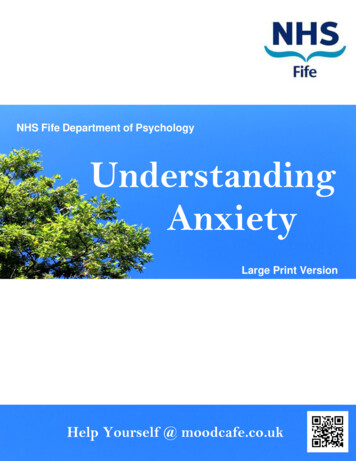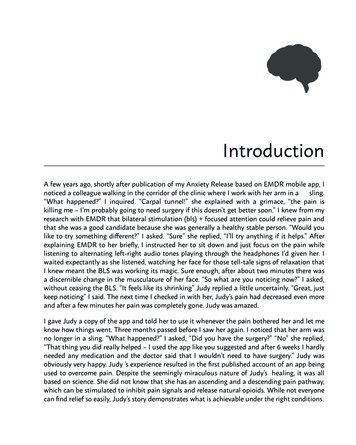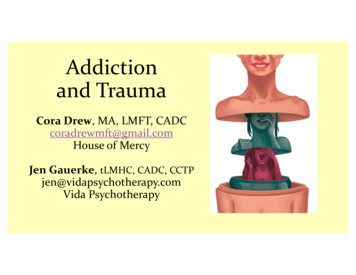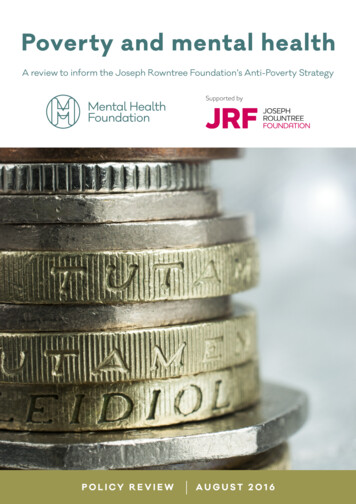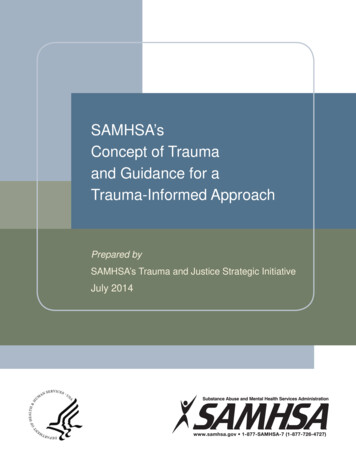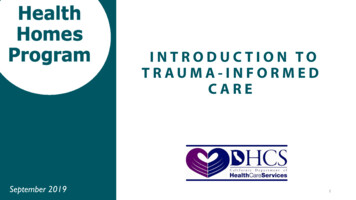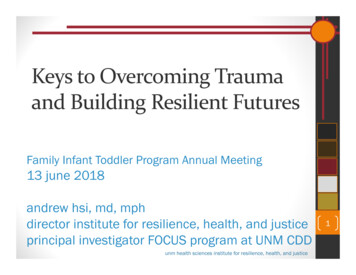
Transcription
Keys to Overcoming Traumaand Building Resilient FuturesFamily Infant Toddler Program Annual Meeting13 june 2018andrew hsi, md, mphdirector institute for resilience, health, and justiceprincipal investigator FOCUS program at UNM CDDunm health sciences institute for resilience, health, and justice1
Objectives for PresentationAt the end of this presentation,attendees will design collaborations for: Epidemiology of prenatal substance exposure, Focused home based early intervention Interventions to reduce developmental effects of exposure Evaluating connection of ACEs to developmental risks Concepts of resilience for parents and infants Planning integrated survivor friendly care: Individual reduced risks of disparate health outcomes Ameliorating effects of Adverse Childhood Experiences Two generation models of survivor friendly careunm health sciences institute for resilience, health, and justice2
Expression of Gratitude NM Fit Program teams NM Department of Health FOCUS and ADOBE teams at UNM HSC Principals when we started in 1990 Medical providers need to care of infants withexposure Home based developmental services Support all parents, no discrimination Understand how to engage families at riskunm health sciences institute for resilience, health, and justice3
Conflict of Interest Statement No financial interests to discloseNo actual families are depicted in this presentationNo expertise in your specific communitiesThe experiences of trauma do not define future destinyCheryl referred from hospital19 years oldGave birth to LorettaUsed heroin in pregnancyunm health sciences institute for resilience, health, and justice4
Cheryl Referred to FOCUS Program 3rd Pregnancy, older child not in Cheryl’s care Gave birth to Loretta Heroin use in first 15 weeks Opioid replacement Subutex Term birth, no problems Loretta had withdrawal 14 day treatment for NOWS Discharged off medication Eddie, her father, present for care Outpatient care starts Detailed history from Cherylunm health sciences institute for resilience, health, and justice5
Cheryl’s Life History with ACEs:Health Risks over The LifespanCheryl’s life eventsRisk EarlyDeathDisease,DisabilityAdoption ofHigh Risk HealthBehaviorsSocial, Emotional, &Cognitive ImpairmentsDisruptedNeurodevelopmentAdverse ChildhoodExperiencesCheryl had no mental health careSexually abused in relative’s homeNeglected and had behavioral issuesJay abusive to Dee in front of CherylJay, Cheryl’s father left familyDee, Cheryl’s mother used heroinunm health sciences institute for resilience, health, and justice6
Clinical Picture of Loretta’sAltered Neuroreceptors Problems from prenatal opioid exposure: Loretta hypertonic from dopamine depletionHard to handle, fussy, low regulation capacitiesFeeding problems, hard to latch on breastSpits up after taking bottle of expressed breast milkCheryl and Eddie at the limits of their parent experienceCheryl feels stressed, has trouble with regulation In past she turned to opioids or benzodiazepines to numb Eddie feels angry, has trouble with regulation They come to FOCUS clinicunm health sciences institute for resilience, health, and justice7
Clinical Interventions How would you prioritize the needsfor Loretta? Cheryl? Eddie? Cheryl most activated by feeding Support her breastfeeding Decrease stimulus around Loretta tohelp latching Observe feeding in exam room Discuss ways of managing stress Guidance around sleep Screen for depression Help Cheryl develop regulation skillsunm health sciences institute for resilience, health, and justice8
Reducing Stress for Family Loretta Swaddling to help decrease motor stimulus Better quiet alert, more organized nursing Eddie; connect with counselor, parenting group9Ntd.tvunm health sciences institute for resilience, health, and justice
Cheryl and Eddie Enroll in FOCUS Assign home based early interventionist Home visits at least monthly to support Loretta’s developmentObserve family in motel room, organize calm area for babyModel capturing infant attention, demonstrate mirroringDemonstrate infant massage, cue reading for touching infant10unm health sciences institute for resilience, health, and justice
Fetal position at 28 weeksNilsson RM, webmd.comunm health sciences institute for resilience, health, and justice
Effect of Altered Dopamine Systems Abnormal inhibition to muscle contraction, high toneWhen dopamineeffect reduced,decreasedcontrol of bodymovements,baby is stiffunm health sciences institute for resilience, health, and justice12
FOCUS and Prevention of ACES Reduce parental stress by supporting Loretta Continuing well child care, monitor head growthDemonstrate supported tummy time in clinicModel language interaction with infant and parentsProvide parents with specific supports for Loretta Psychologist on clinic team to do brief counseling Primary care appointments for Eddie and Cheryl Medication assisted treatment with Suboxone Stabilize opiate receptors, reduce relapse risks Medication as needed for depression, anxiety Stabilize serotonin receptor systemsunm health sciences institute for resilience, health, and justice13
Engagement and Height ChangeStandardized Length/Height Parameters (in percentiles) for Babies withData from Birth to Two Years, by FOCUS Clinic Engagement Measures605040Low-Medium N 2030High N sth6monm3onthrths0BiHeight of Baby(in percentiles)by ClinicAppointmentEngagementMeasuresAge of Babyunm health sciences institute for resilience, health, and justice14
Use of Cocaine, Crack, or Heroin byEngagement Level, First Year in FOCUS6050HighEngagement40% Mothers 30UsingCrack, 20Cocaine,10HeroinLow andMediumEngagement01st Qtr2nd Qtr 3rd Qtr4th QtrEngagement as kept home visits, medical appointments,Babies’Age in Quartersfollow throughon developmentalrecommendationsunm health sciences institute for resilience, health, and justice15
FOCUS Program Directed at 2Generation Effects of ACEs Loretta’s brain has “deformation” from exposure Support of infant after receiving treatment for NOWS Persistent hypertonia; stimulus response regulation Neuromotor intervention, supported tummy time Counters hypertonia in extensor groups Model how parents can help Bring parents to floor to play Reduce risk of child neglect16unm health sciences institute for resilience, health, and justice
Reduce ACEs Effects on Parents Cheryl and Eddie’s brains with deformation Chronic opioid use changes opiate receptor systemsAlso down regulates dopamine, serotoninBuprenorphine saturates opiate receptorsStabilizes neurotransmitters, restores equilibrium Home based early intervention Provides concrete support to read infant cues Supports positive touch to aid development Requires parents to change for infantunm health sciences institute for resilience, health, and justice17
Dopamine Pathways andLearningAnterior cingulateEssential formemoryformation leadingto learningunm health sciences institute for resilience, health, and justice18
Infant Development at Risk Abnormal inhibition to external sounds after exposureWhen dopamineeffect reduced,decreasedmemoryformationunm health sciences institute for resilience, health, and justice19
Expressive Language After Exposure Delays between 1and 3 years of age Primary exposure Poor dopamineinhibition Environment noisy Affect extreme orspeaks in monotone Receptive normal Research on language Higher income homes Greater numbers of word use More specific positive praise20 times per hour “I like how you ate bananas.” Open ended language “How did you draw that?” Predicted 8th gradeprogress Model in FOCUS workHart and Risley, 1995, Meaningful Differences in the EverydayExperience of Young American Childrenunm health sciences institute for resilience, health, and justice20
Sequence of Developmental SkillsSensitive period forappropriatestimulationIdeally, parents are present and prepared to fallin love with infant at critical timesunm health sciences institute for resilience, health, and justice21
Developmental Sequences in Loretta’s Brain Skills build over first years of life Home based case management Helps Cheryl in her home with LorettaModel support for infant developmentModel emotional regulation, expressive language skillsEssential skills for developing attachments Help build parents’ learning, dopamine responsesunm health sciences institute for resilience, health, and justice
Overview “You can’t learn empathy fromsomething that can’t empathize– and without reciprocity andinteraction during teaching,language learning is severelyimpaired.” M Szalavitz, B Perry Born for Love, 2010 HarperCollins Publishers, New York, NY, page216unm health sciences institute for resilience, health, and justice23
FOCUS Aiding Parenting Home based case management Helps Cheryl in her home with Loretta Model support for infant development Model emotional regulation “Educating” a parent is okay: But not enough to achieve normalchild development Modeling support for Loretta forCheryl and Eddie Services to meet needs not basedon curriculum24unm health sciences institute for resilience, health, and justice
Development Supported byParental Emotional Development Loretta’s ability to master reading dependson: Supportive emotional environmentMastery of early skills to provide foundationRepeated opportunities to practiceGrowth of self-regulationSupports advanced skills like readingPositive reinforcement by caregiversCan’t skip steps Growing skills create attachment Changes dopamine in Cheryl and Eddie’s brainsunm health sciences institute for resilience, health, and justice25
Assets Relevant to 3‐5 Year Olds External assets to the child Support from family, other adults, neighbors, and communityEmpowerment; valued in community, safety, service to othersBoundaries and Expectations made clearConstructive use of time for age Internal qualities in the child Committed to learning age appropriatePositive values; communicated from universal family valuesSocial competencies appropriate for ageDevelopment of positive identity; personal power, self-esteem,sense of purpose, positive view of personal future Sample of guidance for appropriate parentingCopyright 2005 by Search Institute, search-institute.orgunm health sciences institute for resilience, health, and justice26
Recovery of brain dopamine transporters in chronicmethamphetamine user after prolonged abstinence.unm health sciences institute for resilience, health, and justice27
OverviewHumans are the product of nature and nurture.Genes and experience are interdependent.Genes are merely chemicals and without“experience” – with no context, nomicroenviromental signals to guide theiractivation or deactivation – create nothing.And “experiences” without a genomic matrixcannot create, regulate or replicate life of anyform.The complex process of creating a human being- and humanity – requires both.BRUCE D. PERRY “Childhood Experience and the Expressionof Genetic Potential: What Childhood Neglect Tells Us AboutNature and Nurture.” 2002 Brain and Mind 3: 79–100unm health sciences institute for resilience, health, and justice28
Health as Sum of Neurotransmission Chronic changes of brainsignaling systems Opioid substance use disorder;changes opiate receptors Down regulation of dopaminesignaling Decreases memory and learning Requires larger stimulus to “feelnormal” Life experienced throughbrain chemistry“I think; therefore I am.” ― René Descartes, 1596-1650unm health sciences institute for resilience, health, and justice29
Connecting Brain Capacities Cognitive, emotional, and social capacities All woven together throughout the life course Brain is a highly integrated organ with multiple functions Capacities operate in coordination with one another Emotional well-being and social competence provide Strong foundation for emerging cognitive abilities Organize development of brain architecture Recovery of normal neurotransmitter in synapses“I remember, therefore I think, therefore I am.”unm health sciences institute for resilience, health, and justice
Improve Serotonin Levels forTreatment of Depression, Anxiety Post partum depression Chronic depression Changes in serotonin signalingsystems in substance usedisorder Affects mood, sleep, anxiety Low levels cause persistent sadness Serotonin affecting medications Frequently prescribed Not physically habit forming Increase availability of naturallyproduced serotoninunm health sciences institute for resilience, health, and justice31
ACEs: Relative Risks of Health BehaviorsAssociated with Risks for Early DeathACE ScoreAlcoholism*IVDrug 4.032.73.54.04 54.55.13.89.27.216.8* 0 adverse events set as standard riskunm health sciences institute for resilience, health, and justice32
Cheryl’s Life History with ACEs:Health Risks over The LifespanCheryl’s life eventsRisk EarlyDeathDisease,DisabilityAdoption ofHigh Risk HealthBehaviorsSocial, Emotional, &Cognitive ImpairmentsDisruptedNeurodevelopmentAdverse ChildhoodExperiencesHepatitis C status pending3rd pregnancy within 4 yearsSports injury led to prescription opiatesage 15, then heroin useAlcohol and marijuana age 12, selfmedicating, no treatmentCheryl had no mental health careSexually abused in relative’s homeNeglected and had behavioral issuesJay abusive to Dee in front of CherylJay, Cheryl’s father left familyDee, Cheryl’s mother used heroinunm health sciences institute for resilience, health, and justice33
Signals Towards Better HealthFills prescription for naloxone to prevent overdoseStart replacement therapy, opiate receptor protectionImplement harm reduction practices,Discuss alcohol, tobacco, marijuana usePARTICIPATION in therapy identifies SuccessesConsistency with appointments,takes medicationsDisease,DisabilityAdoption ofHigh Risk HealthBehaviorsAllows home visits, participates indevelopmental support of childunm health sciences institute for resilience, health, and justice34
Drawing on Resilience to See theWorld Through Loretta’s EyesParent attends education, job entry, goes to work regularlyDevelops support group of safe peopleAdvocates for development of infantBuild normal emotional andintellectual development fortheir infantSocial, Emotional, &Cognitive ImpairmentsDisruptedNeurodevelopmentCreates safe loving home for infantAdverse ChildhoodExperiencesunm health sciences institute for resilience, health, and justice35
Shonkoff, Center for the Developing Child36unm health sciences institute for resilience, health, and justice
Concepts of Resilience Achieve outcome greater than expected Resilience from cohort study Werner, et al Personal qualities; personality, talent Someone who gave child unconditional love Adults as gatekeepers SUD as chronic recurring disorder Parallels to cancer; presentation, remission, relapse Therapy may cure, or achieve remission, lengthen life Anticipate relapse; support parenting “How did you manage to arrive today withyour child?”unm health sciences institute for resilience, health, and justice37
Characteristics of Survivor FriendlyPrimary Care for Families Trauma-informed model of care Expect probable underlying mental health challenges Recognize relapse potential of substance use disorder Avoids depersonalizing and stressful interactions that canthemselves be traumatizing for patients Survivor Friendly Primary Care for families All of above and Engage individual in specific view of health/function Congratulate for making it to clinic Achieve continuity of care, build trustunm health sciences institute for resilience, health, and justice38
Goal Question for Cheryl and Eddie What do you want for your child? Answer: Graduate high school! Questions What do you need to be there? What will we do at this visit? Create small daily changes Draw on resilience for health39unm health sciences institute for resilience, health, and justice
Shonkoff, Center for the Developing Child40unm health sciences institute for resilience, health, and justice
Issues of Recovery as Family Expect parents to make changes Become appropriate advocates Normalize daily activity schedule Take medication daily Attend counseling, learn new ways Apply learning to tomorrow Requires system changes Build willingness to engage with family Commit to continuity with providersunm health sciences institute for resilience, health, and justice41
Connecting the InterventionHealthierConcepts AcrossGenerationsLivesDisease &Healthier StatusDisabilityReductionofAdoptionof HealthHealth-riskriskBehaviorsSocial, Emotional, & h Seeking StatusAdoption of HealthierBehaviorsLorettaSocial, Emotional, & CognitiveSkill AcquisitionRegulatedNeurodevelopmentAdverse ChildhoodExperiencesAdverse ChildhoodExperiences; NOWSCheryl and EddieBrain Altered by Prenatal Exposure to DrugsCollaborative Intervention to Reduce Generational Impact ofAdverse Childhood ExperiencesTolerableStressunm health sciences institute for resilience, health, and justice42
Loretta Will Have Lowered Risk HealthBehaviors Associated with ACEsACE scoreAlcoholismIV Drug .032.73.54.044.53.87.2 55.19.216.843* 0 adverse events set as standard riskof 1.0unm health sciences institute for resilience, health, and justice
Health as BalanceA mother found meth in hercar. She’d been stable formany months. She usedand felt bad. Consider allthe times she’d beenaround drugs and didn’tuse. If she had come acrossdrugs 99 times before andused once, how do weevaluate her progress?unm health sciences institute for resilience, health, and justice44
Quotes Regarding Desire in Recovery “So, if desire cannot be turned off or seduced awayfrom addictive goals, immediate goals, then it hasto be fastened to goals incompatible with addiction Freedom from sufferingAchievement of life projectsAccess to loving relationshipsSense of coherence and self-love” “The trick to overcoming addictions is thus The realignment of desire Switches from goal of immediate relief To the goal of Long-term Fulfillment”Mark Lewis. The Biology of Desire: Why Addiction is not a Disease. 2015. Perseus Booksunm health sciences institute for resilience, health, and justice45
Challenges for Future What happens to the babies as they age? Do the parents stay sober? Developmental challenges persist for those exposed They will become what our society wants for them The parents will have the health we support Long term goal for the familyParents love and advocate for children46unm health sciences institute for resilience, health, and justice
FOCUS: Key to Building Resilience Principals when we started in 1990 Medical providers (some) care for infants with exposureSome medical providers willing to care for parentsHome based developmental services are standardSome children better prepared for formal educationSupport all parents and infants, some discrimination existsIncomplete understanding of how to engage families at risk Fund data systems for long term education outcomes Consider the meaning of child protective services Healing or prosecution will require consensusunm health sciences institute for resilience, health, and justice47
Recovery As Experienced by Persons inRecovery Handling negative feelings without use of drugs or alcohol Being able to enjoy life without drinking or using drugs like Iused to Being honest with myself A process of growth and development Reacting to life’s ups and downs in a more balanced waythan I used to Taking responsibility for the things I can change (LAKaskutas. Elements That Define Recovery: The Experiential Perspective. J Stud AlcoholDrugs,75, 999-1010, 2014)unm health sciences institute for resilience, health, and justice48
Health as Existence in Present49unm health sciences institute for resilience, health, and justice
Thank You for Your Dedicationahsi@salud.unm.eduResources/references http://www.drugabuse.gov/ http://www.samhsa.gov/ Lakaskutas. Elements That Define Recovery: The Experiential Perspective. JStud Alcohol Drugs,75, 999-1010, 2014 Mark Lewis. The Biology of Desire: Why Addiction is not a Disease. 2015.Perseus Books The Compass of Pleasure: How Our Brains Make Fatty Foods, Orgasm,Exercise, Marijuana, Generosity, Vodka, Learning And Gambling Feel So Good(David J Linden) The Addict: One Patient, One Doctor, One Year (Michael Stein) In the Realm of Hungry Ghosts (Gabor Maté) diction-disease-freewillunm health sciences institute for resilience, health, and justice50
Keys to Overcoming Trauma . Social, Emotional, & Cognitive Impairments Adoption of High Risk Health . What Childhood Neglect Tells Us About Nature and Nurture." 2002 Brain and Mind 3: 79-100 28. unm health sciences institute for resilience, health, and justice


